Literature Review of a Specific aspect of Glatiramer
VerifiedAdded on 2023/06/10
|10
|2704
|398
AI Summary
This literature review discusses the mechanism of action, adverse effects, and drug-induced thrombocytopenia of Glatiramer, an immunomodulatory agent used in the treatment of multiple sclerosis. The review presents a case study of a patient with Glatiramer-induced thrombocytopenia, and discusses the challenges of diagnosing drug-related thrombocytopenia. The review also provides an overview of the efficacy of Glatiramer in reducing disease progression in patients with multiple sclerosis, and discusses the potential of immunomodulatory treatments for MS.
Contribute Materials
Your contribution can guide someone’s learning journey. Share your
documents today.
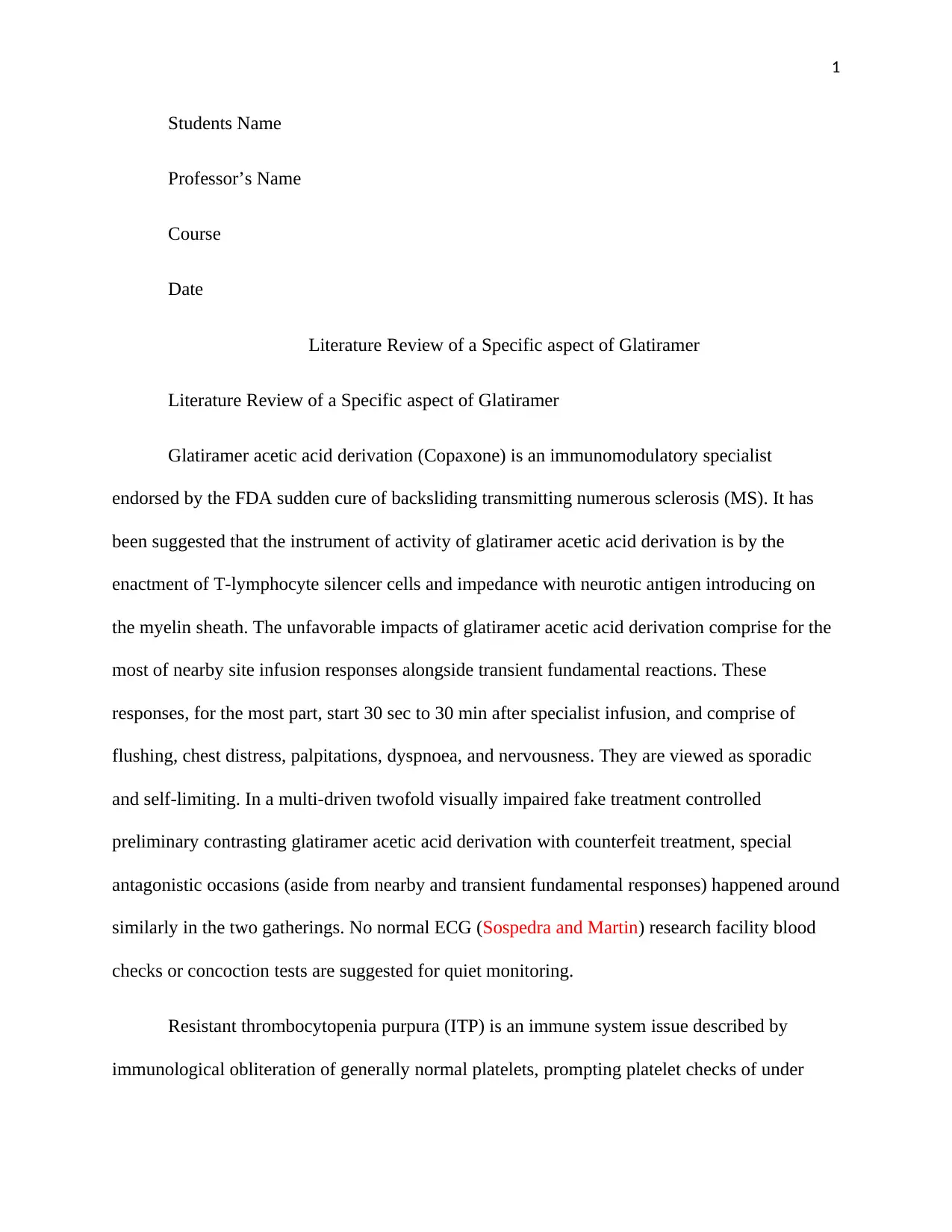
1
Students Name
Professor’s Name
Course
Date
Literature Review of a Specific aspect of Glatiramer
Literature Review of a Specific aspect of Glatiramer
Glatiramer acetic acid derivation (Copaxone) is an immunomodulatory specialist
endorsed by the FDA sudden cure of backsliding transmitting numerous sclerosis (MS). It has
been suggested that the instrument of activity of glatiramer acetic acid derivation is by the
enactment of T-lymphocyte silencer cells and impedance with neurotic antigen introducing on
the myelin sheath. The unfavorable impacts of glatiramer acetic acid derivation comprise for the
most of nearby site infusion responses alongside transient fundamental reactions. These
responses, for the most part, start 30 sec to 30 min after specialist infusion, and comprise of
flushing, chest distress, palpitations, dyspnoea, and nervousness. They are viewed as sporadic
and self-limiting. In a multi-driven twofold visually impaired fake treatment controlled
preliminary contrasting glatiramer acetic acid derivation with counterfeit treatment, special
antagonistic occasions (aside from nearby and transient fundamental responses) happened around
similarly in the two gatherings. No normal ECG (Sospedra and Martin) research facility blood
checks or concoction tests are suggested for quiet monitoring.
Resistant thrombocytopenia purpura (ITP) is an immune system issue described by
immunological obliteration of generally normal platelets, prompting platelet checks of under
Students Name
Professor’s Name
Course
Date
Literature Review of a Specific aspect of Glatiramer
Literature Review of a Specific aspect of Glatiramer
Glatiramer acetic acid derivation (Copaxone) is an immunomodulatory specialist
endorsed by the FDA sudden cure of backsliding transmitting numerous sclerosis (MS). It has
been suggested that the instrument of activity of glatiramer acetic acid derivation is by the
enactment of T-lymphocyte silencer cells and impedance with neurotic antigen introducing on
the myelin sheath. The unfavorable impacts of glatiramer acetic acid derivation comprise for the
most of nearby site infusion responses alongside transient fundamental reactions. These
responses, for the most part, start 30 sec to 30 min after specialist infusion, and comprise of
flushing, chest distress, palpitations, dyspnoea, and nervousness. They are viewed as sporadic
and self-limiting. In a multi-driven twofold visually impaired fake treatment controlled
preliminary contrasting glatiramer acetic acid derivation with counterfeit treatment, special
antagonistic occasions (aside from nearby and transient fundamental responses) happened around
similarly in the two gatherings. No normal ECG (Sospedra and Martin) research facility blood
checks or concoction tests are suggested for quiet monitoring.
Resistant thrombocytopenia purpura (ITP) is an immune system issue described by
immunological obliteration of generally normal platelets, prompting platelet checks of under
Secure Best Marks with AI Grader
Need help grading? Try our AI Grader for instant feedback on your assignments.
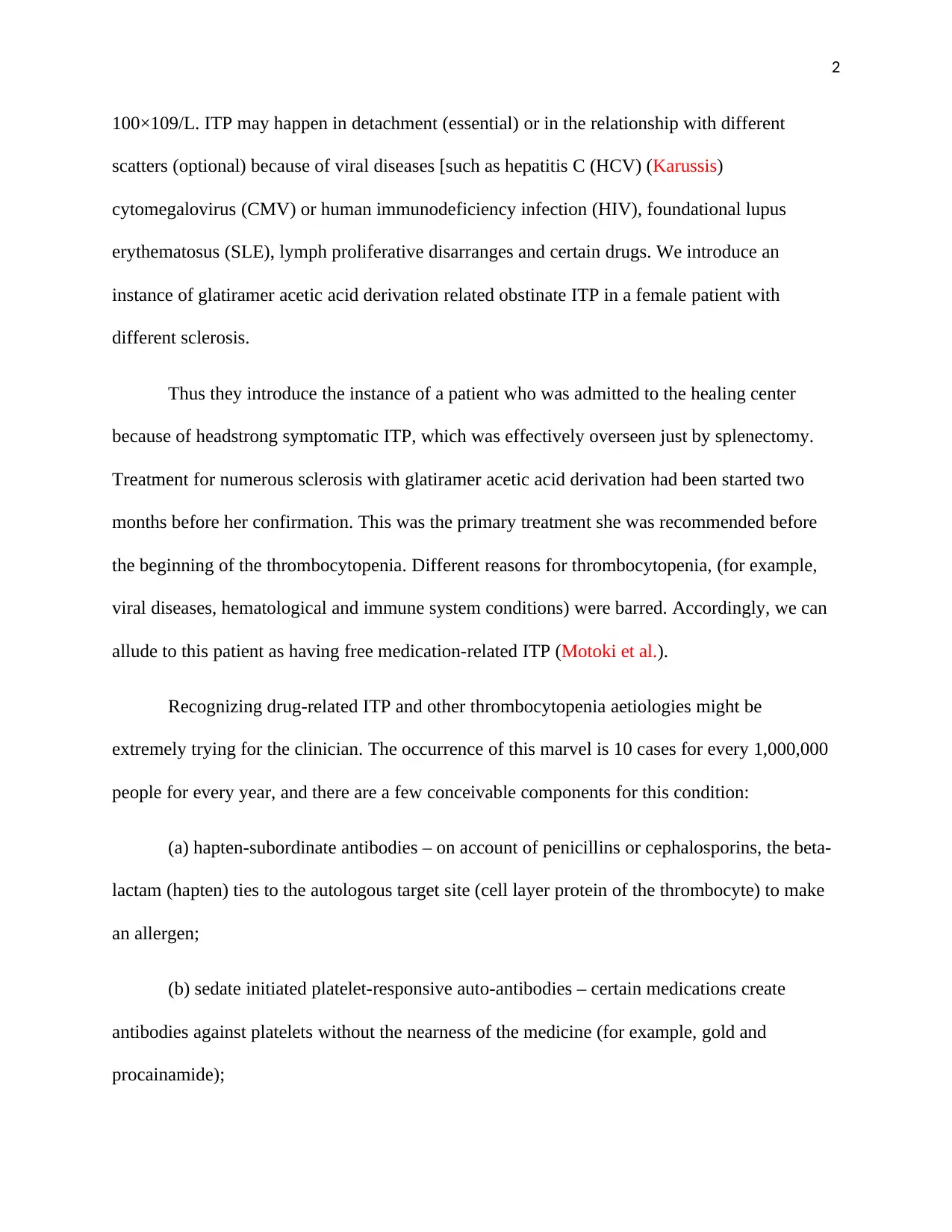
2
100×109/L. ITP may happen in detachment (essential) or in the relationship with different
scatters (optional) because of viral diseases [such as hepatitis C (HCV) (Karussis)
cytomegalovirus (CMV) or human immunodeficiency infection (HIV), foundational lupus
erythematosus (SLE), lymph proliferative disarranges and certain drugs. We introduce an
instance of glatiramer acetic acid derivation related obstinate ITP in a female patient with
different sclerosis.
Thus they introduce the instance of a patient who was admitted to the healing center
because of headstrong symptomatic ITP, which was effectively overseen just by splenectomy.
Treatment for numerous sclerosis with glatiramer acetic acid derivation had been started two
months before her confirmation. This was the primary treatment she was recommended before
the beginning of the thrombocytopenia. Different reasons for thrombocytopenia, (for example,
viral diseases, hematological and immune system conditions) were barred. Accordingly, we can
allude to this patient as having free medication-related ITP (Motoki et al.).
Recognizing drug-related ITP and other thrombocytopenia aetiologies might be
extremely trying for the clinician. The occurrence of this marvel is 10 cases for every 1,000,000
people for every year, and there are a few conceivable components for this condition:
(a) hapten-subordinate antibodies – on account of penicillins or cephalosporins, the beta-
lactam (hapten) ties to the autologous target site (cell layer protein of the thrombocyte) to make
an allergen;
(b) sedate initiated platelet-responsive auto-antibodies – certain medications create
antibodies against platelets without the nearness of the medicine (for example, gold and
procainamide);
100×109/L. ITP may happen in detachment (essential) or in the relationship with different
scatters (optional) because of viral diseases [such as hepatitis C (HCV) (Karussis)
cytomegalovirus (CMV) or human immunodeficiency infection (HIV), foundational lupus
erythematosus (SLE), lymph proliferative disarranges and certain drugs. We introduce an
instance of glatiramer acetic acid derivation related obstinate ITP in a female patient with
different sclerosis.
Thus they introduce the instance of a patient who was admitted to the healing center
because of headstrong symptomatic ITP, which was effectively overseen just by splenectomy.
Treatment for numerous sclerosis with glatiramer acetic acid derivation had been started two
months before her confirmation. This was the primary treatment she was recommended before
the beginning of the thrombocytopenia. Different reasons for thrombocytopenia, (for example,
viral diseases, hematological and immune system conditions) were barred. Accordingly, we can
allude to this patient as having free medication-related ITP (Motoki et al.).
Recognizing drug-related ITP and other thrombocytopenia aetiologies might be
extremely trying for the clinician. The occurrence of this marvel is 10 cases for every 1,000,000
people for every year, and there are a few conceivable components for this condition:
(a) hapten-subordinate antibodies – on account of penicillins or cephalosporins, the beta-
lactam (hapten) ties to the autologous target site (cell layer protein of the thrombocyte) to make
an allergen;
(b) sedate initiated platelet-responsive auto-antibodies – certain medications create
antibodies against platelets without the nearness of the medicine (for example, gold and
procainamide);
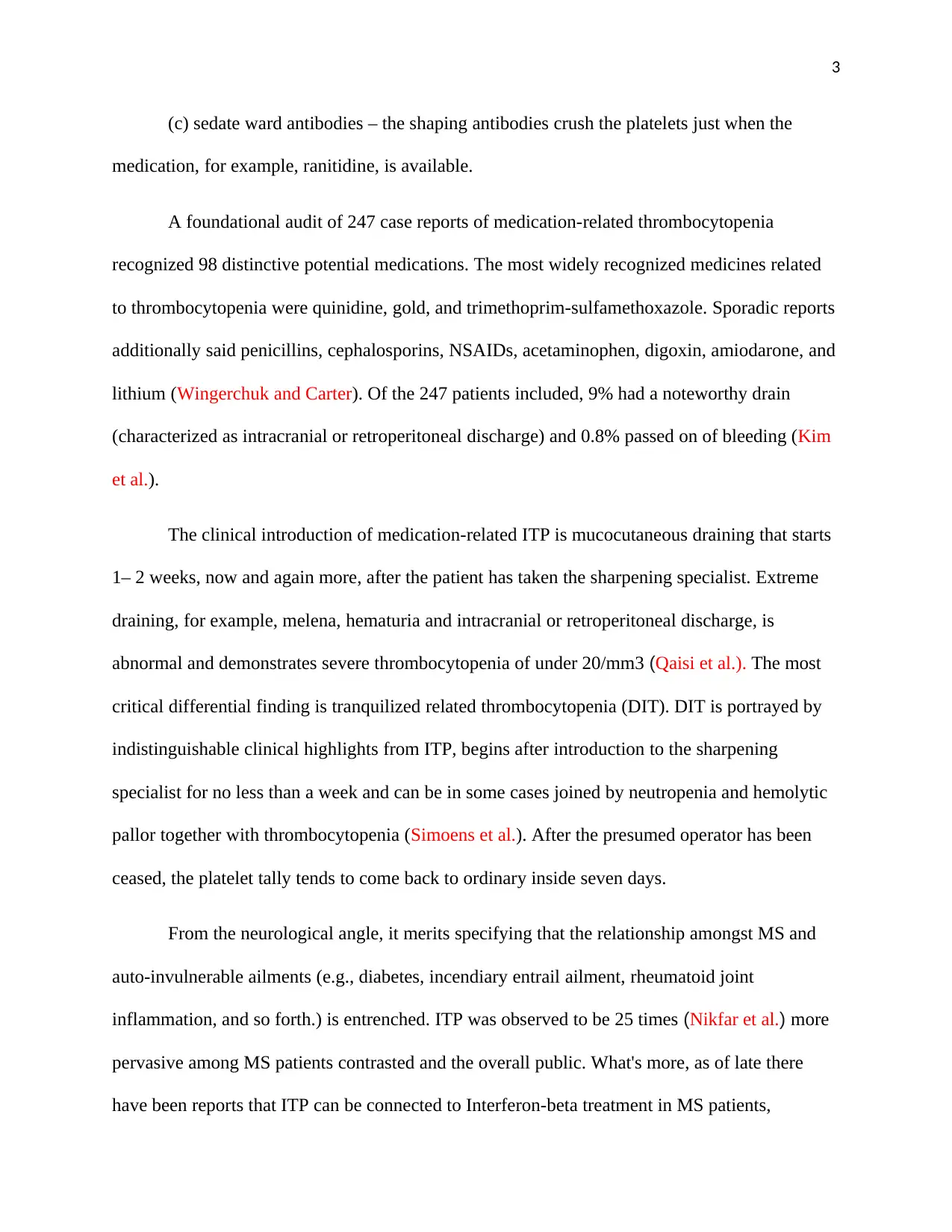
3
(c) sedate ward antibodies – the shaping antibodies crush the platelets just when the
medication, for example, ranitidine, is available.
A foundational audit of 247 case reports of medication-related thrombocytopenia
recognized 98 distinctive potential medications. The most widely recognized medicines related
to thrombocytopenia were quinidine, gold, and trimethoprim-sulfamethoxazole. Sporadic reports
additionally said penicillins, cephalosporins, NSAIDs, acetaminophen, digoxin, amiodarone, and
lithium (Wingerchuk and Carter). Of the 247 patients included, 9% had a noteworthy drain
(characterized as intracranial or retroperitoneal discharge) and 0.8% passed on of bleeding (Kim
et al.).
The clinical introduction of medication-related ITP is mucocutaneous draining that starts
1– 2 weeks, now and again more, after the patient has taken the sharpening specialist. Extreme
draining, for example, melena, hematuria and intracranial or retroperitoneal discharge, is
abnormal and demonstrates severe thrombocytopenia of under 20/mm3 (Qaisi et al.). The most
critical differential finding is tranquilized related thrombocytopenia (DIT). DIT is portrayed by
indistinguishable clinical highlights from ITP, begins after introduction to the sharpening
specialist for no less than a week and can be in some cases joined by neutropenia and hemolytic
pallor together with thrombocytopenia (Simoens et al.). After the presumed operator has been
ceased, the platelet tally tends to come back to ordinary inside seven days.
From the neurological angle, it merits specifying that the relationship amongst MS and
auto-invulnerable ailments (e.g., diabetes, incendiary entrail ailment, rheumatoid joint
inflammation, and so forth.) is entrenched. ITP was observed to be 25 times (Nikfar et al.) more
pervasive among MS patients contrasted and the overall public. What's more, as of late there
have been reports that ITP can be connected to Interferon-beta treatment in MS patients,
(c) sedate ward antibodies – the shaping antibodies crush the platelets just when the
medication, for example, ranitidine, is available.
A foundational audit of 247 case reports of medication-related thrombocytopenia
recognized 98 distinctive potential medications. The most widely recognized medicines related
to thrombocytopenia were quinidine, gold, and trimethoprim-sulfamethoxazole. Sporadic reports
additionally said penicillins, cephalosporins, NSAIDs, acetaminophen, digoxin, amiodarone, and
lithium (Wingerchuk and Carter). Of the 247 patients included, 9% had a noteworthy drain
(characterized as intracranial or retroperitoneal discharge) and 0.8% passed on of bleeding (Kim
et al.).
The clinical introduction of medication-related ITP is mucocutaneous draining that starts
1– 2 weeks, now and again more, after the patient has taken the sharpening specialist. Extreme
draining, for example, melena, hematuria and intracranial or retroperitoneal discharge, is
abnormal and demonstrates severe thrombocytopenia of under 20/mm3 (Qaisi et al.). The most
critical differential finding is tranquilized related thrombocytopenia (DIT). DIT is portrayed by
indistinguishable clinical highlights from ITP, begins after introduction to the sharpening
specialist for no less than a week and can be in some cases joined by neutropenia and hemolytic
pallor together with thrombocytopenia (Simoens et al.). After the presumed operator has been
ceased, the platelet tally tends to come back to ordinary inside seven days.
From the neurological angle, it merits specifying that the relationship amongst MS and
auto-invulnerable ailments (e.g., diabetes, incendiary entrail ailment, rheumatoid joint
inflammation, and so forth.) is entrenched. ITP was observed to be 25 times (Nikfar et al.) more
pervasive among MS patients contrasted and the overall public. What's more, as of late there
have been reports that ITP can be connected to Interferon-beta treatment in MS patients,
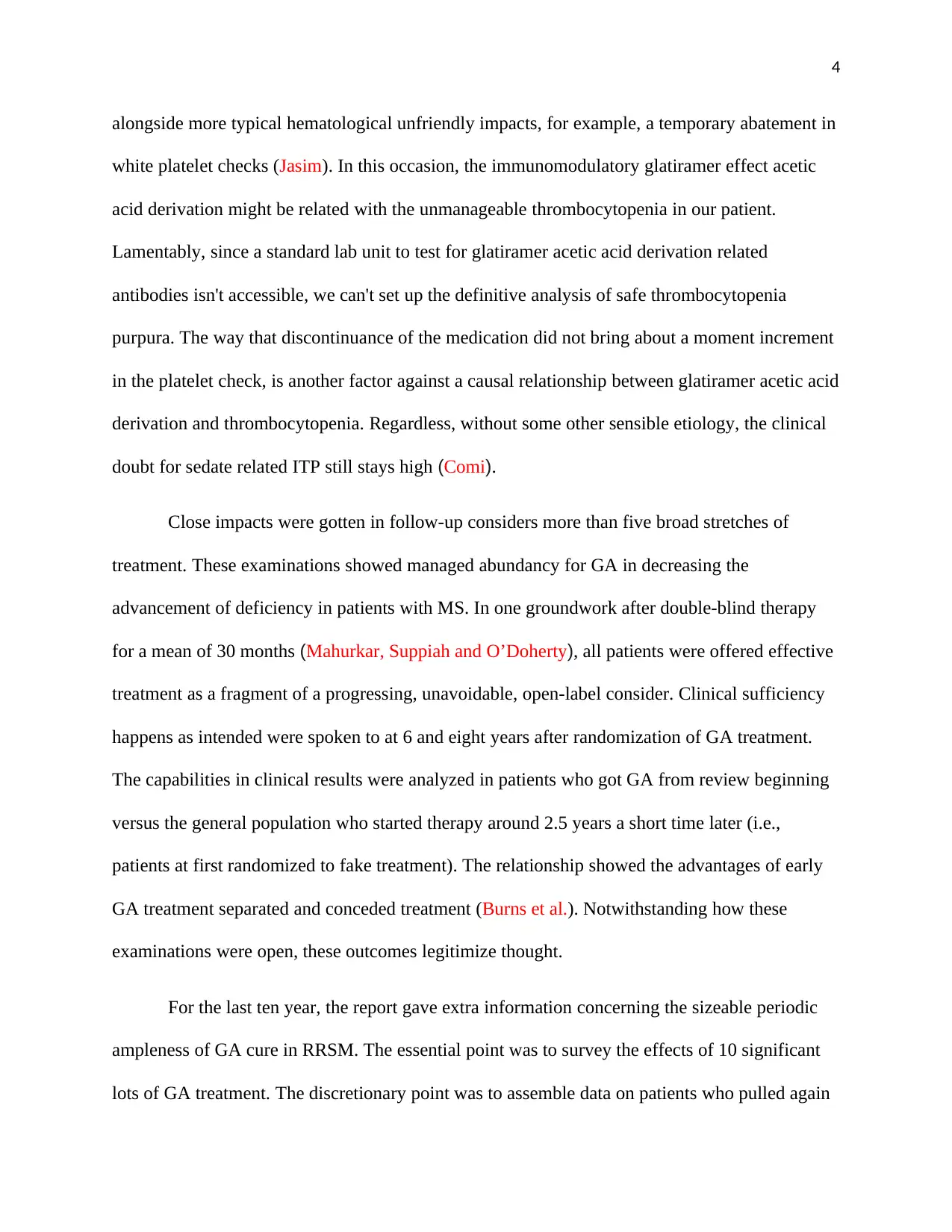
4
alongside more typical hematological unfriendly impacts, for example, a temporary abatement in
white platelet checks (Jasim). In this occasion, the immunomodulatory glatiramer effect acetic
acid derivation might be related with the unmanageable thrombocytopenia in our patient.
Lamentably, since a standard lab unit to test for glatiramer acetic acid derivation related
antibodies isn't accessible, we can't set up the definitive analysis of safe thrombocytopenia
purpura. The way that discontinuance of the medication did not bring about a moment increment
in the platelet check, is another factor against a causal relationship between glatiramer acetic acid
derivation and thrombocytopenia. Regardless, without some other sensible etiology, the clinical
doubt for sedate related ITP still stays high (Comi).
Close impacts were gotten in follow-up considers more than five broad stretches of
treatment. These examinations showed managed abundancy for GA in decreasing the
advancement of deficiency in patients with MS. In one groundwork after double‐blind therapy
for a mean of 30 months (Mahurkar, Suppiah and O’Doherty), all patients were offered effective
treatment as a fragment of a progressing, unavoidable, open-label consider. Clinical sufficiency
happens as intended were spoken to at 6 and eight years after randomization of GA treatment.
The capabilities in clinical results were analyzed in patients who got GA from review beginning
versus the general population who started therapy around 2.5 years a short time later (i.e.,
patients at first randomized to fake treatment). The relationship showed the advantages of early
GA treatment separated and conceded treatment (Burns et al.). Notwithstanding how these
examinations were open, these outcomes legitimize thought.
For the last ten year, the report gave extra information concerning the sizeable periodic
ampleness of GA cure in RRSM. The essential point was to survey the effects of 10 significant
lots of GA treatment. The discretionary point was to assemble data on patients who pulled again
alongside more typical hematological unfriendly impacts, for example, a temporary abatement in
white platelet checks (Jasim). In this occasion, the immunomodulatory glatiramer effect acetic
acid derivation might be related with the unmanageable thrombocytopenia in our patient.
Lamentably, since a standard lab unit to test for glatiramer acetic acid derivation related
antibodies isn't accessible, we can't set up the definitive analysis of safe thrombocytopenia
purpura. The way that discontinuance of the medication did not bring about a moment increment
in the platelet check, is another factor against a causal relationship between glatiramer acetic acid
derivation and thrombocytopenia. Regardless, without some other sensible etiology, the clinical
doubt for sedate related ITP still stays high (Comi).
Close impacts were gotten in follow-up considers more than five broad stretches of
treatment. These examinations showed managed abundancy for GA in decreasing the
advancement of deficiency in patients with MS. In one groundwork after double‐blind therapy
for a mean of 30 months (Mahurkar, Suppiah and O’Doherty), all patients were offered effective
treatment as a fragment of a progressing, unavoidable, open-label consider. Clinical sufficiency
happens as intended were spoken to at 6 and eight years after randomization of GA treatment.
The capabilities in clinical results were analyzed in patients who got GA from review beginning
versus the general population who started therapy around 2.5 years a short time later (i.e.,
patients at first randomized to fake treatment). The relationship showed the advantages of early
GA treatment separated and conceded treatment (Burns et al.). Notwithstanding how these
examinations were open, these outcomes legitimize thought.
For the last ten year, the report gave extra information concerning the sizeable periodic
ampleness of GA cure in RRSM. The essential point was to survey the effects of 10 significant
lots of GA treatment. The discretionary point was to assemble data on patients who pulled again
Secure Best Marks with AI Grader
Need help grading? Try our AI Grader for instant feedback on your assignments.
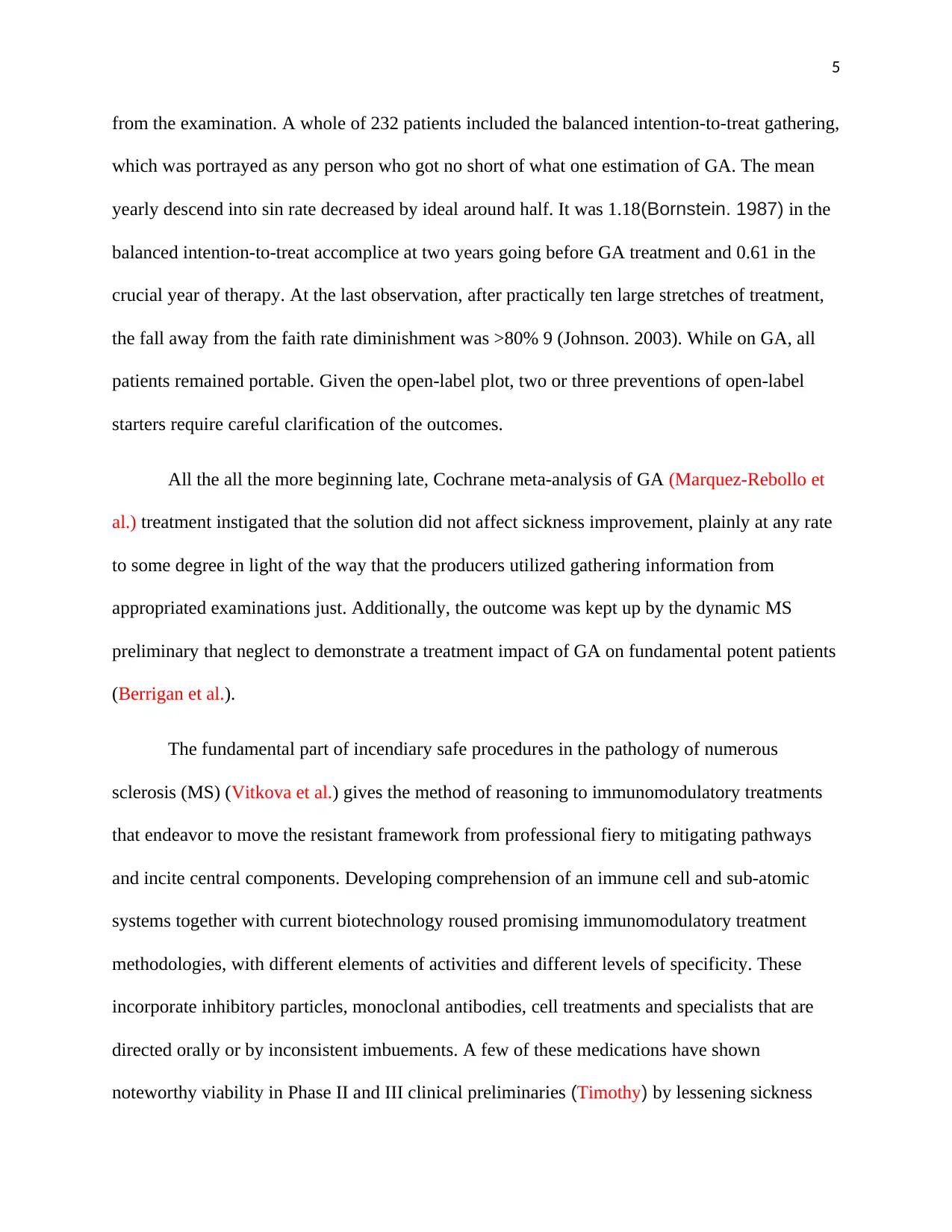
5
from the examination. A whole of 232 patients included the balanced intention‐to‐treat gathering,
which was portrayed as any person who got no short of what one estimation of GA. The mean
yearly descend into sin rate decreased by ideal around half. It was 1.18(Bornstein. 1987) in the
balanced intention‐to‐treat accomplice at two years going before GA treatment and 0.61 in the
crucial year of therapy. At the last observation, after practically ten large stretches of treatment,
the fall away from the faith rate diminishment was >80% 9 (Johnson. 2003). While on GA, all
patients remained portable. Given the open‐label plot, two or three preventions of open‐label
starters require careful clarification of the outcomes.
All the all the more beginning late, Cochrane meta‐analysis of GA (Marquez-Rebollo et
al.) treatment instigated that the solution did not affect sickness improvement, plainly at any rate
to some degree in light of the way that the producers utilized gathering information from
appropriated examinations just. Additionally, the outcome was kept up by the dynamic MS
preliminary that neglect to demonstrate a treatment impact of GA on fundamental potent patients
(Berrigan et al.).
The fundamental part of incendiary safe procedures in the pathology of numerous
sclerosis (MS) (Vitkova et al.) gives the method of reasoning to immunomodulatory treatments
that endeavor to move the resistant framework from professional fiery to mitigating pathways
and incite central components. Developing comprehension of an immune cell and sub-atomic
systems together with current biotechnology roused promising immunomodulatory treatment
methodologies, with different elements of activities and different levels of specificity. These
incorporate inhibitory particles, monoclonal antibodies, cell treatments and specialists that are
directed orally or by inconsistent imbuements. A few of these medications have shown
noteworthy viability in Phase II and III clinical preliminaries (Timothy) by lessening sickness
from the examination. A whole of 232 patients included the balanced intention‐to‐treat gathering,
which was portrayed as any person who got no short of what one estimation of GA. The mean
yearly descend into sin rate decreased by ideal around half. It was 1.18(Bornstein. 1987) in the
balanced intention‐to‐treat accomplice at two years going before GA treatment and 0.61 in the
crucial year of therapy. At the last observation, after practically ten large stretches of treatment,
the fall away from the faith rate diminishment was >80% 9 (Johnson. 2003). While on GA, all
patients remained portable. Given the open‐label plot, two or three preventions of open‐label
starters require careful clarification of the outcomes.
All the all the more beginning late, Cochrane meta‐analysis of GA (Marquez-Rebollo et
al.) treatment instigated that the solution did not affect sickness improvement, plainly at any rate
to some degree in light of the way that the producers utilized gathering information from
appropriated examinations just. Additionally, the outcome was kept up by the dynamic MS
preliminary that neglect to demonstrate a treatment impact of GA on fundamental potent patients
(Berrigan et al.).
The fundamental part of incendiary safe procedures in the pathology of numerous
sclerosis (MS) (Vitkova et al.) gives the method of reasoning to immunomodulatory treatments
that endeavor to move the resistant framework from professional fiery to mitigating pathways
and incite central components. Developing comprehension of an immune cell and sub-atomic
systems together with current biotechnology roused promising immunomodulatory treatment
methodologies, with different elements of activities and different levels of specificity. These
incorporate inhibitory particles, monoclonal antibodies, cell treatments and specialists that are
directed orally or by inconsistent imbuements. A few of these medications have shown
noteworthy viability in Phase II and III clinical preliminaries (Timothy) by lessening sickness
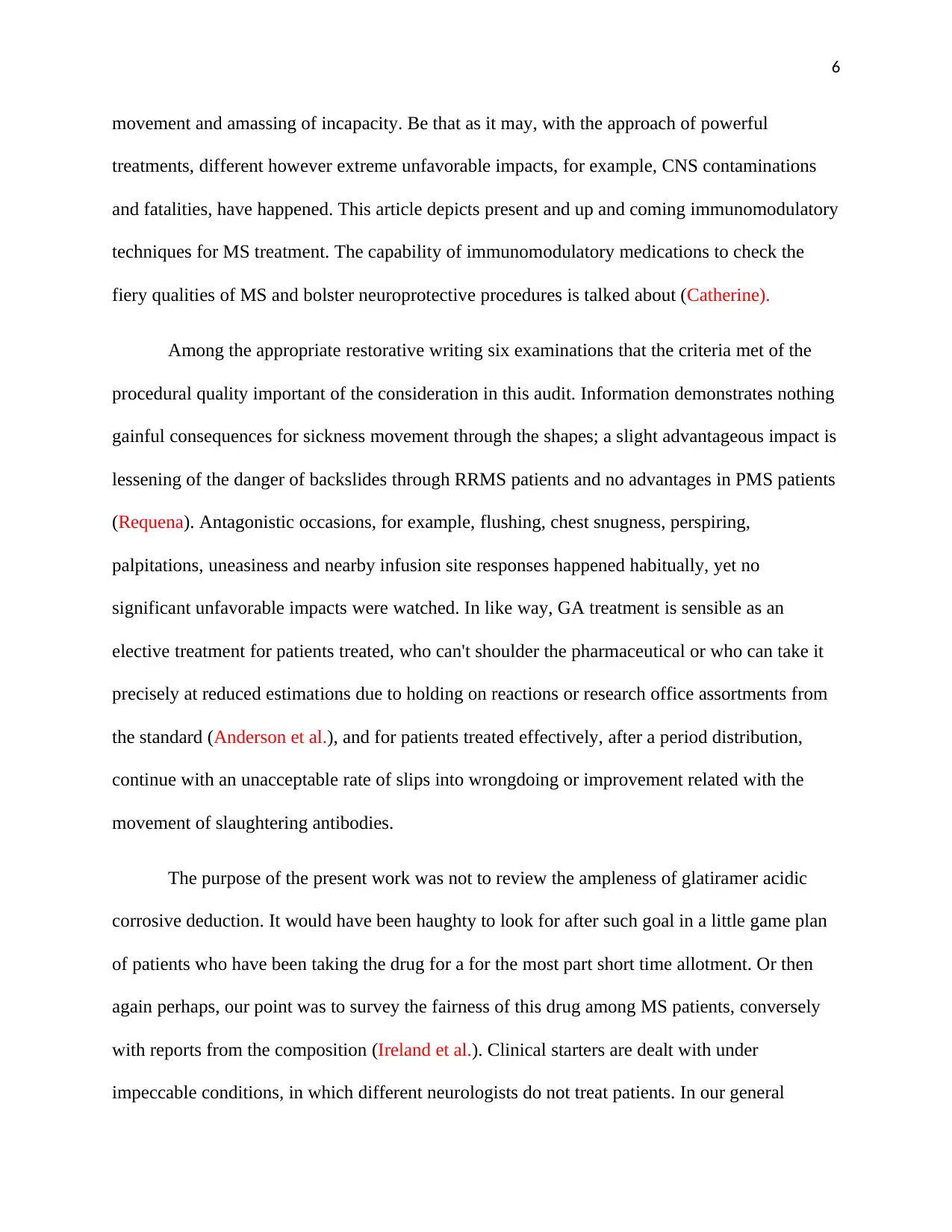
6
movement and amassing of incapacity. Be that as it may, with the approach of powerful
treatments, different however extreme unfavorable impacts, for example, CNS contaminations
and fatalities, have happened. This article depicts present and up and coming immunomodulatory
techniques for MS treatment. The capability of immunomodulatory medications to check the
fiery qualities of MS and bolster neuroprotective procedures is talked about (Catherine).
Among the appropriate restorative writing six examinations that the criteria met of the
procedural quality important of the consideration in this audit. Information demonstrates nothing
gainful consequences for sickness movement through the shapes; a slight advantageous impact is
lessening of the danger of backslides through RRMS patients and no advantages in PMS patients
(Requena). Antagonistic occasions, for example, flushing, chest snugness, perspiring,
palpitations, uneasiness and nearby infusion site responses happened habitually, yet no
significant unfavorable impacts were watched. In like way, GA treatment is sensible as an
elective treatment for patients treated, who can't shoulder the pharmaceutical or who can take it
precisely at reduced estimations due to holding on reactions or research office assortments from
the standard (Anderson et al.), and for patients treated effectively, after a period distribution,
continue with an unacceptable rate of slips into wrongdoing or improvement related with the
movement of slaughtering antibodies.
The purpose of the present work was not to review the ampleness of glatiramer acidic
corrosive deduction. It would have been haughty to look for after such goal in a little game plan
of patients who have been taking the drug for a for the most part short time allotment. Or then
again perhaps, our point was to survey the fairness of this drug among MS patients, conversely
with reports from the composition (Ireland et al.). Clinical starters are dealt with under
impeccable conditions, in which different neurologists do not treat patients. In our general
movement and amassing of incapacity. Be that as it may, with the approach of powerful
treatments, different however extreme unfavorable impacts, for example, CNS contaminations
and fatalities, have happened. This article depicts present and up and coming immunomodulatory
techniques for MS treatment. The capability of immunomodulatory medications to check the
fiery qualities of MS and bolster neuroprotective procedures is talked about (Catherine).
Among the appropriate restorative writing six examinations that the criteria met of the
procedural quality important of the consideration in this audit. Information demonstrates nothing
gainful consequences for sickness movement through the shapes; a slight advantageous impact is
lessening of the danger of backslides through RRMS patients and no advantages in PMS patients
(Requena). Antagonistic occasions, for example, flushing, chest snugness, perspiring,
palpitations, uneasiness and nearby infusion site responses happened habitually, yet no
significant unfavorable impacts were watched. In like way, GA treatment is sensible as an
elective treatment for patients treated, who can't shoulder the pharmaceutical or who can take it
precisely at reduced estimations due to holding on reactions or research office assortments from
the standard (Anderson et al.), and for patients treated effectively, after a period distribution,
continue with an unacceptable rate of slips into wrongdoing or improvement related with the
movement of slaughtering antibodies.
The purpose of the present work was not to review the ampleness of glatiramer acidic
corrosive deduction. It would have been haughty to look for after such goal in a little game plan
of patients who have been taking the drug for a for the most part short time allotment. Or then
again perhaps, our point was to survey the fairness of this drug among MS patients, conversely
with reports from the composition (Ireland et al.). Clinical starters are dealt with under
impeccable conditions, in which different neurologists do not treat patients. In our general
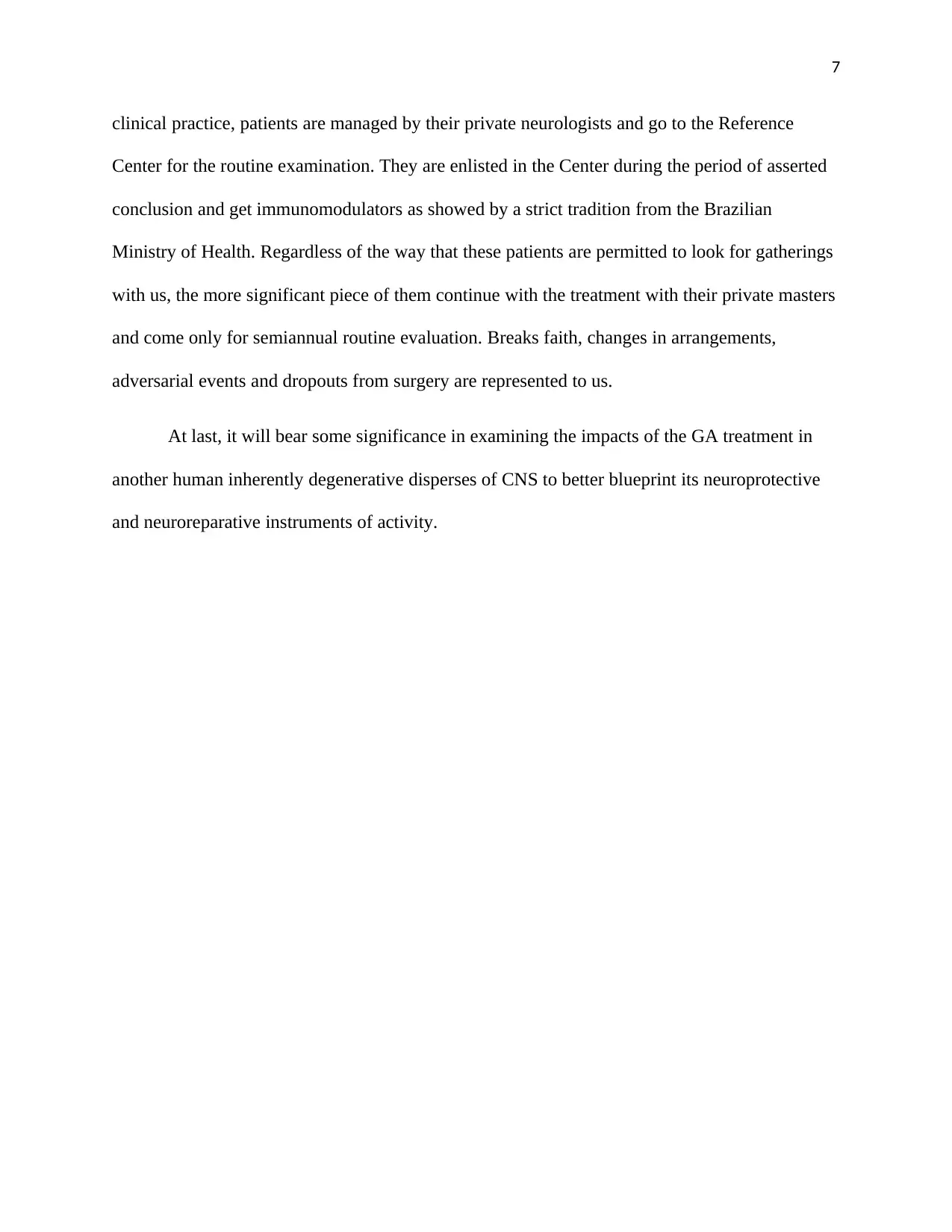
7
clinical practice, patients are managed by their private neurologists and go to the Reference
Center for the routine examination. They are enlisted in the Center during the period of asserted
conclusion and get immunomodulators as showed by a strict tradition from the Brazilian
Ministry of Health. Regardless of the way that these patients are permitted to look for gatherings
with us, the more significant piece of them continue with the treatment with their private masters
and come only for semiannual routine evaluation. Breaks faith, changes in arrangements,
adversarial events and dropouts from surgery are represented to us.
At last, it will bear some significance in examining the impacts of the GA treatment in
another human inherently degenerative disperses of CNS to better blueprint its neuroprotective
and neuroreparative instruments of activity.
clinical practice, patients are managed by their private neurologists and go to the Reference
Center for the routine examination. They are enlisted in the Center during the period of asserted
conclusion and get immunomodulators as showed by a strict tradition from the Brazilian
Ministry of Health. Regardless of the way that these patients are permitted to look for gatherings
with us, the more significant piece of them continue with the treatment with their private masters
and come only for semiannual routine evaluation. Breaks faith, changes in arrangements,
adversarial events and dropouts from surgery are represented to us.
At last, it will bear some significance in examining the impacts of the GA treatment in
another human inherently degenerative disperses of CNS to better blueprint its neuroprotective
and neuroreparative instruments of activity.
Paraphrase This Document
Need a fresh take? Get an instant paraphrase of this document with our AI Paraphraser
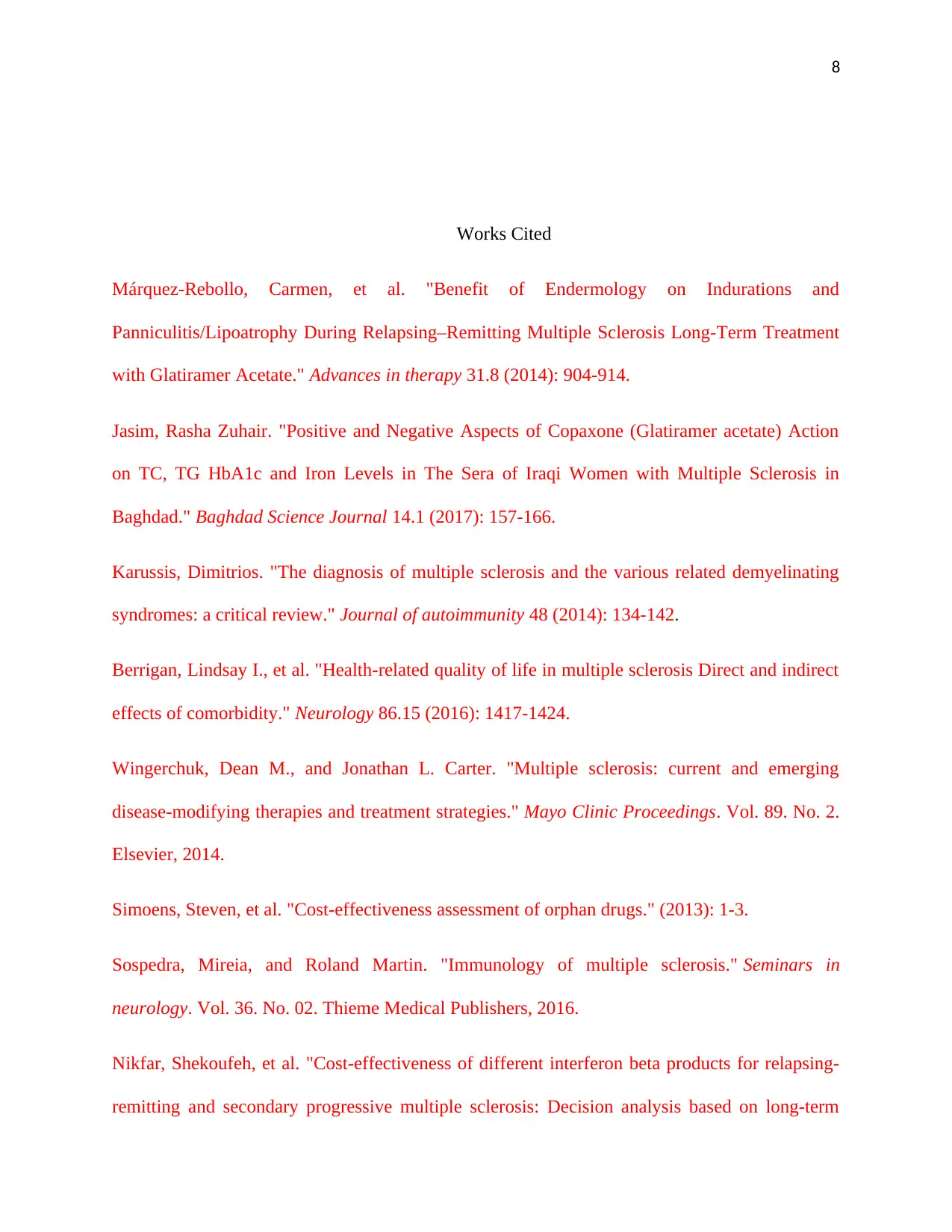
8
Works Cited
Márquez-Rebollo, Carmen, et al. "Benefit of Endermology on Indurations and
Panniculitis/Lipoatrophy During Relapsing–Remitting Multiple Sclerosis Long-Term Treatment
with Glatiramer Acetate." Advances in therapy 31.8 (2014): 904-914.
Jasim, Rasha Zuhair. "Positive and Negative Aspects of Copaxone (Glatiramer acetate) Action
on TC, TG HbA1c and Iron Levels in The Sera of Iraqi Women with Multiple Sclerosis in
Baghdad." Baghdad Science Journal 14.1 (2017): 157-166.
Karussis, Dimitrios. "The diagnosis of multiple sclerosis and the various related demyelinating
syndromes: a critical review." Journal of autoimmunity 48 (2014): 134-142.
Berrigan, Lindsay I., et al. "Health-related quality of life in multiple sclerosis Direct and indirect
effects of comorbidity." Neurology 86.15 (2016): 1417-1424.
Wingerchuk, Dean M., and Jonathan L. Carter. "Multiple sclerosis: current and emerging
disease-modifying therapies and treatment strategies." Mayo Clinic Proceedings. Vol. 89. No. 2.
Elsevier, 2014.
Simoens, Steven, et al. "Cost-effectiveness assessment of orphan drugs." (2013): 1-3.
Sospedra, Mireia, and Roland Martin. "Immunology of multiple sclerosis." Seminars in
neurology. Vol. 36. No. 02. Thieme Medical Publishers, 2016.
Nikfar, Shekoufeh, et al. "Cost-effectiveness of different interferon beta products for relapsing-
remitting and secondary progressive multiple sclerosis: Decision analysis based on long-term
Works Cited
Márquez-Rebollo, Carmen, et al. "Benefit of Endermology on Indurations and
Panniculitis/Lipoatrophy During Relapsing–Remitting Multiple Sclerosis Long-Term Treatment
with Glatiramer Acetate." Advances in therapy 31.8 (2014): 904-914.
Jasim, Rasha Zuhair. "Positive and Negative Aspects of Copaxone (Glatiramer acetate) Action
on TC, TG HbA1c and Iron Levels in The Sera of Iraqi Women with Multiple Sclerosis in
Baghdad." Baghdad Science Journal 14.1 (2017): 157-166.
Karussis, Dimitrios. "The diagnosis of multiple sclerosis and the various related demyelinating
syndromes: a critical review." Journal of autoimmunity 48 (2014): 134-142.
Berrigan, Lindsay I., et al. "Health-related quality of life in multiple sclerosis Direct and indirect
effects of comorbidity." Neurology 86.15 (2016): 1417-1424.
Wingerchuk, Dean M., and Jonathan L. Carter. "Multiple sclerosis: current and emerging
disease-modifying therapies and treatment strategies." Mayo Clinic Proceedings. Vol. 89. No. 2.
Elsevier, 2014.
Simoens, Steven, et al. "Cost-effectiveness assessment of orphan drugs." (2013): 1-3.
Sospedra, Mireia, and Roland Martin. "Immunology of multiple sclerosis." Seminars in
neurology. Vol. 36. No. 02. Thieme Medical Publishers, 2016.
Nikfar, Shekoufeh, et al. "Cost-effectiveness of different interferon beta products for relapsing-
remitting and secondary progressive multiple sclerosis: Decision analysis based on long-term
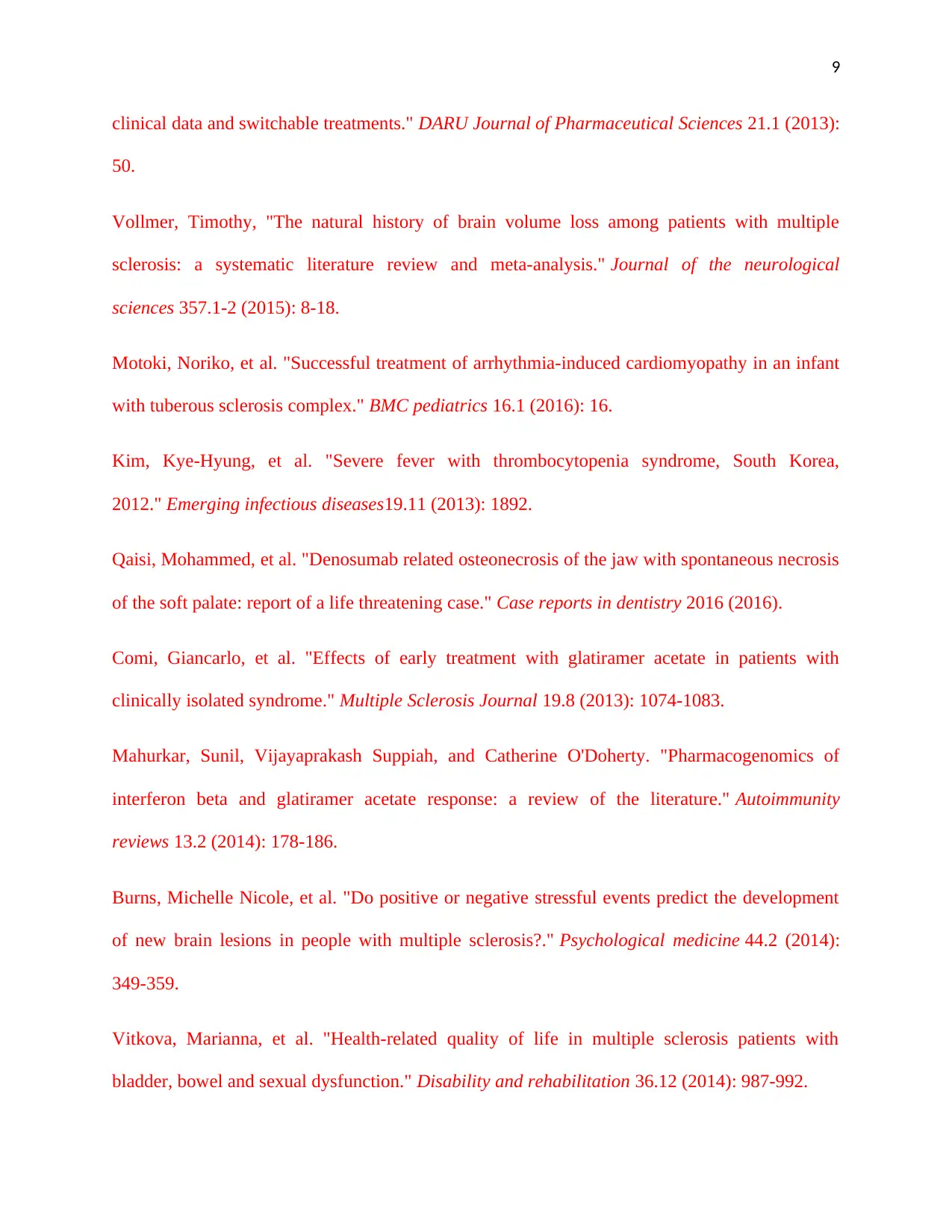
9
clinical data and switchable treatments." DARU Journal of Pharmaceutical Sciences 21.1 (2013):
50.
Vollmer, Timothy, "The natural history of brain volume loss among patients with multiple
sclerosis: a systematic literature review and meta-analysis." Journal of the neurological
sciences 357.1-2 (2015): 8-18.
Motoki, Noriko, et al. "Successful treatment of arrhythmia-induced cardiomyopathy in an infant
with tuberous sclerosis complex." BMC pediatrics 16.1 (2016): 16.
Kim, Kye-Hyung, et al. "Severe fever with thrombocytopenia syndrome, South Korea,
2012." Emerging infectious diseases19.11 (2013): 1892.
Qaisi, Mohammed, et al. "Denosumab related osteonecrosis of the jaw with spontaneous necrosis
of the soft palate: report of a life threatening case." Case reports in dentistry 2016 (2016).
Comi, Giancarlo, et al. "Effects of early treatment with glatiramer acetate in patients with
clinically isolated syndrome." Multiple Sclerosis Journal 19.8 (2013): 1074-1083.
Mahurkar, Sunil, Vijayaprakash Suppiah, and Catherine O'Doherty. "Pharmacogenomics of
interferon beta and glatiramer acetate response: a review of the literature." Autoimmunity
reviews 13.2 (2014): 178-186.
Burns, Michelle Nicole, et al. "Do positive or negative stressful events predict the development
of new brain lesions in people with multiple sclerosis?." Psychological medicine 44.2 (2014):
349-359.
Vitkova, Marianna, et al. "Health-related quality of life in multiple sclerosis patients with
bladder, bowel and sexual dysfunction." Disability and rehabilitation 36.12 (2014): 987-992.
clinical data and switchable treatments." DARU Journal of Pharmaceutical Sciences 21.1 (2013):
50.
Vollmer, Timothy, "The natural history of brain volume loss among patients with multiple
sclerosis: a systematic literature review and meta-analysis." Journal of the neurological
sciences 357.1-2 (2015): 8-18.
Motoki, Noriko, et al. "Successful treatment of arrhythmia-induced cardiomyopathy in an infant
with tuberous sclerosis complex." BMC pediatrics 16.1 (2016): 16.
Kim, Kye-Hyung, et al. "Severe fever with thrombocytopenia syndrome, South Korea,
2012." Emerging infectious diseases19.11 (2013): 1892.
Qaisi, Mohammed, et al. "Denosumab related osteonecrosis of the jaw with spontaneous necrosis
of the soft palate: report of a life threatening case." Case reports in dentistry 2016 (2016).
Comi, Giancarlo, et al. "Effects of early treatment with glatiramer acetate in patients with
clinically isolated syndrome." Multiple Sclerosis Journal 19.8 (2013): 1074-1083.
Mahurkar, Sunil, Vijayaprakash Suppiah, and Catherine O'Doherty. "Pharmacogenomics of
interferon beta and glatiramer acetate response: a review of the literature." Autoimmunity
reviews 13.2 (2014): 178-186.
Burns, Michelle Nicole, et al. "Do positive or negative stressful events predict the development
of new brain lesions in people with multiple sclerosis?." Psychological medicine 44.2 (2014):
349-359.
Vitkova, Marianna, et al. "Health-related quality of life in multiple sclerosis patients with
bladder, bowel and sexual dysfunction." Disability and rehabilitation 36.12 (2014): 987-992.
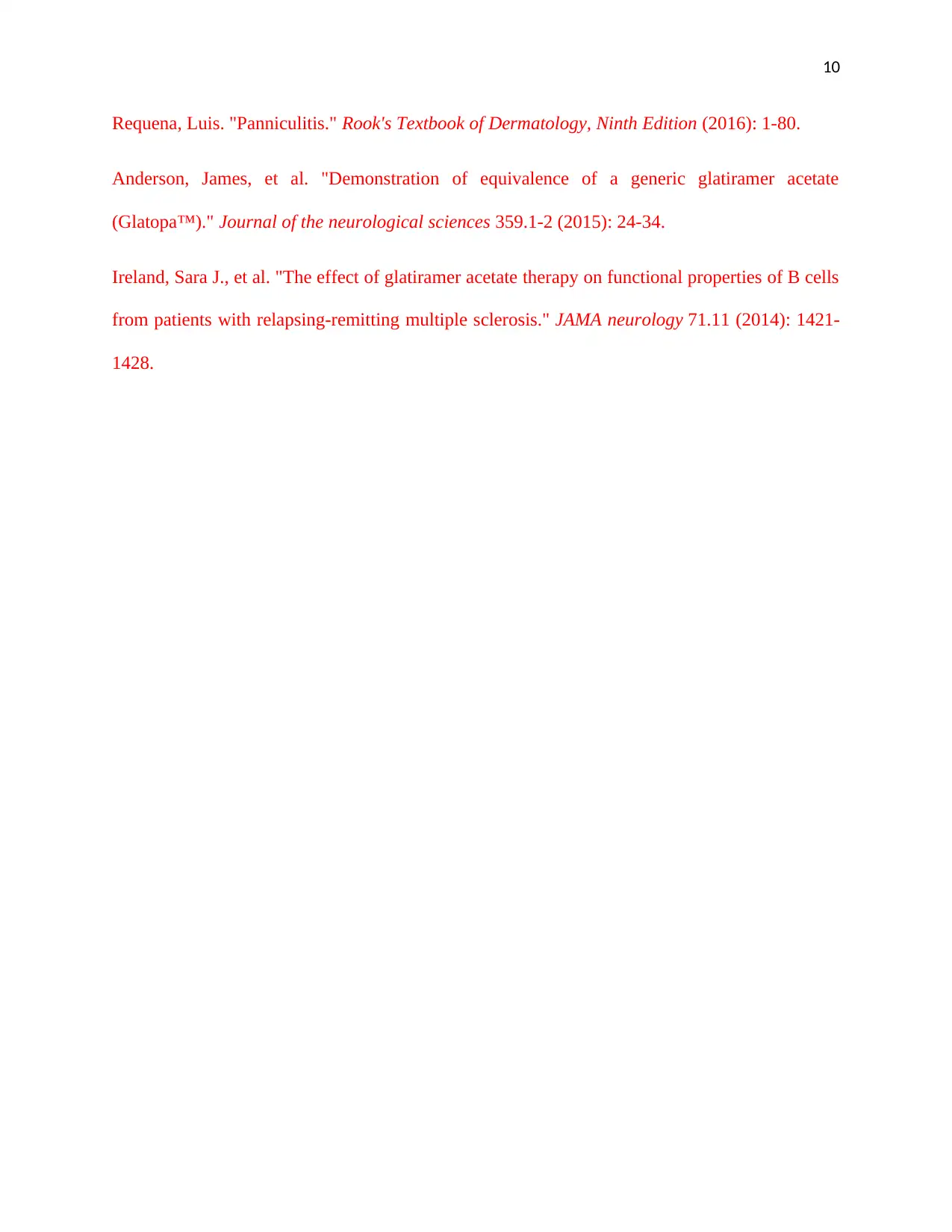
10
Requena, Luis. "Panniculitis." Rook's Textbook of Dermatology, Ninth Edition (2016): 1-80.
Anderson, James, et al. "Demonstration of equivalence of a generic glatiramer acetate
(Glatopa™)." Journal of the neurological sciences 359.1-2 (2015): 24-34.
Ireland, Sara J., et al. "The effect of glatiramer acetate therapy on functional properties of B cells
from patients with relapsing-remitting multiple sclerosis." JAMA neurology 71.11 (2014): 1421-
1428.
Requena, Luis. "Panniculitis." Rook's Textbook of Dermatology, Ninth Edition (2016): 1-80.
Anderson, James, et al. "Demonstration of equivalence of a generic glatiramer acetate
(Glatopa™)." Journal of the neurological sciences 359.1-2 (2015): 24-34.
Ireland, Sara J., et al. "The effect of glatiramer acetate therapy on functional properties of B cells
from patients with relapsing-remitting multiple sclerosis." JAMA neurology 71.11 (2014): 1421-
1428.
1 out of 10
Your All-in-One AI-Powered Toolkit for Academic Success.
+13062052269
info@desklib.com
Available 24*7 on WhatsApp / Email
![[object Object]](/_next/static/media/star-bottom.7253800d.svg)
Unlock your academic potential
© 2024 | Zucol Services PVT LTD | All rights reserved.